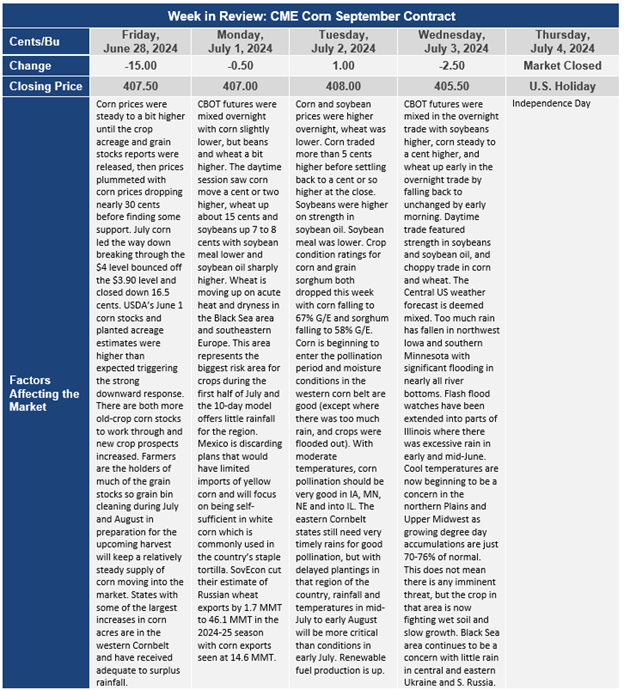Chicago Board of Trade Market News

Outlook
USDA’s grain stocks and planted acreage reports that were released on June 28th both were considered negative for corn as there was more corn on hand than expected and corn acreage was higher than expected given some of the planting problems that occurred this spring.
Corn stocks in all positions on June 1, 2024, totaled 4.99 billion bushels, up 21.7 percent from June 1, 2023, and the largest since June 2020. Of the total stocks, 3.026 billion bushels are stored on farms, up 36.5 percent from a year earlier. Off-farm stocks, at 1.967 billion bushels, are up 4.3 percent from a year ago. The March – May 2024 indicated disappearance is 3.36 billion bushels, compared with 3.29 billion bushels during the same period last year. The implied March-May feed and residual disappearance is 916 million bushels, 125 million bushels below expectations. But the implied feed and residual disappearance for the September-May period is up 5% from last year. The most recent WASDE report has 2023/24 feed and residual, up 5% from the previous year so the current usage levels reported by USDA are in alignment with the stocks number. Of the major corn producing states, on-farm stocks are up the greatest in Illinois (+71.2%) and up the least in Wisconsin (+4.8%). Off-farm corn stocks are up the greatest in Illinois (+23.1%) and down the most in Iowa (-15.5%). For total corn grain stocks, the state with the highest percentage increase in total stocks was Illinois (+43.6%) followed closely by Missouri (+40%). The state with the lowest percentage gain in corn stocks was Wisconsin (+3.2%) followed closely by Nebraska (+5.3%).
The USDA planted acreage report surprised the market with an increase in corn planted acres despite the problems getting the crop planted, especially in the eastern side of the Cornbelt. USDA reported that farmers planted 91.5 million acres of corn, down 3.6% from a year ago, but 1.6% greater than the corn acreage in the March planting intentions report. Acreage in Iowa was 2.3% higher than anticipated in March, acres in Minnesota were 2.5% higher than intentions, Nebraska up 2.5%, and Kansas 10.5% higher than March intentions. Illinois, Indiana, Missouri, and Kentucky were unchanged from March intentions. For the U.S., the June corn crop acreage estimate has been between 97% and 101% of final acreage. In 2023, the June corn crop acreage was 99% of the final acreage. Corn acreage harvested for grain in the U.S. averages 90% of the June corn acreage number with the recent low being 89%. Most of the difference between planted corn acres and harvested corn acres is corn that is harvested for corn silage.
With increased planted acres for corn and with crop condition ratings that have declined every week since the first report of the season, the corn outlook may not have changed as much as some would think. Yes, there are likely to be more acres harvested, but the national yield is likely to be less than the current 181 bushels per acre that USDA has in the June WASDE. Thus, if yield is 179 bushels per acre, production would be about 70 million bushels more than USDA had in the June WASDE. Exports are running ahead of expectations, and feed and ethanol demand are matching expectations, so ending stocks for 2023/24 may eventually be reduced by 25 million bushels from the June WASDE and total demand for corn in the 2024/25 marketing year is apt to be 200 million bushels greater than 2023/24 and 100 million bushels higher than in the latest WASDE. The bottom line is ending stocks for 2024/25 may only grow by 40 million bushels compared to 2023/24 and could actually be 50 million bushels less than the June WASDE estimate for 2024/25. It is clear that the market will be oversupplied if U.S. corn yield reaches 181-182 bushels per acre, but if yields drop to 175 bushels per acre or less then a much greater burden will be put on Argentinian weather in December-January and Brazilian weather in March through May of 2025. Word on the street is that some Argentinian producers may be reluctant to plant corn in the coming season following major disease issues this year.
